#american Jazz standards
Text
Die Flugblattaffäre. (Welche Auswirkungen sie hatte und Nachtrag.)
Tipp Ei Po. *Tipico
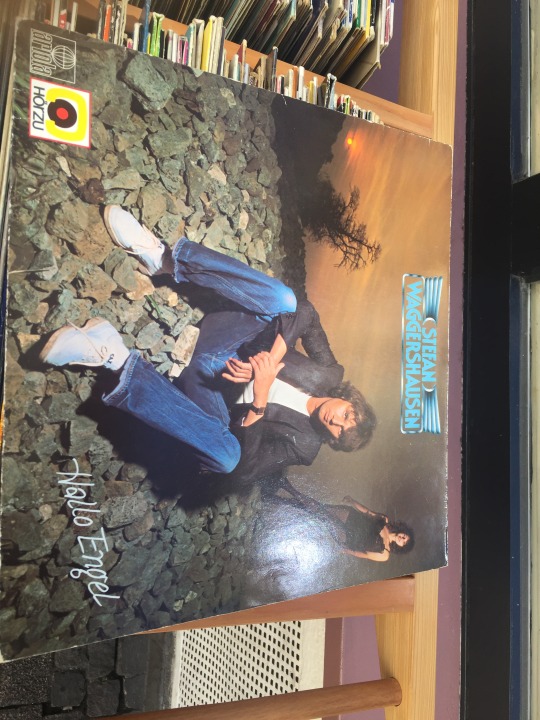













'Tipp Ei Po' (Tipico als Sponsor des FC Bayern Münchens)
'Alles was noch danach kam, oder weil es das so noch konnte'

'Why not then take just all of you'

Erinnerungskultur.


'Deutsche besaßen nach dem 2. Weltkrieg generell zu viele und zu große Erinnerungsluecken. Und so wurden auch nur wenige der damaligen Täter und Mittäter später wirklich vor Gericht belangt dafuer und bestraft'. Es sind aber immer andere Zahlungsformen oder Weisen noch genauso denkbar, wie man auch 'bezahlen' kann, selbst ein jetziger Wohnungsinhaber der die Wohnung vom Vorgänger übernahm (nicht jüdisch).



tief schlafender sitzender Buddha (mit von beiden Händen geformten Herzzeichen) *der gealterte Butt oder Ar***. das 'h' als Einzelbuchstabe nur und in der engl. Sprechweise.




Das Showbusiness, dem anderen eine gute Show lediglich immer wieder nur noch genauso auch dar zu bieten, das beherrschen heutzutage längst schon auch andere! Es muss nicht immer nur derjenige sein so der es einst erfand, (und somit also der Angelsachse!)


'Heidelberg, du hast mich wieder!!' (Eher war es hier Darmstadt.)

Sack + Sch(w)ul + hoch.


'Holt sofort jetzt den Direktor!'
'Aber sind sie es denn nicht selber??'
'Ich bin es nur gewesen, aber das liegt schon sehr lange zurueck!! Und auch nur für Musik!!'
'Genauer gesagt liegt das nun schon ueber 35 Jahre zurueck!'
'Sie wirken aber gar nicht so, als wären sie in der Tat schon so alt, wie sie sagen!'
#american Jazz standards#All of me#die Erinnerungskultur#cool#Türen#Schulen#Wie ist der aktuelle Schuldenstand#der Schuldenabtrag#Schulden ausgleichen#Schulden ganz streichen#etwas gut machen#Alles wird gut!
0 notes
Text








SONG OF THE WEEK: “Ac-Cent-Tchu-Ate the Positive.” https://johnnyjblairsingeratlarge.bandcamp.com/track/ac-cent-tchu-ate-the-positive This song was written by the great American songwriters, Harold Arlen & Johnny Mercer in 1944. Mercer sang it in the style of a sermon. He described his inspiration for the lyrics: "[My] publicity agent went to hear a sermon by Father Divine, and his subject was 'you got to accentuate the positive and eliminate the negative.’ …and I said 'Wow, that's a colorful phrase!'" The song has been covered many times in diverse styles, from country to jazz to punk. It reached me through the film soundtrack L.A. CONFIDENTIAL.
This track is from my collection of songs I play in assisted living homes. For some time I've been performing for people in various stages of dementia and disability. I've seen miraculous things happen while singing to people who are considered to be "disconnected"—suddenly they're singing, clapping, tapping, dancing...all because of these familiar tunes. There is proof-positive that music reaches into more areas of the brain than language, math, and other forms of communication. You can help me to continue this work. Your download my music helps to underwrite my expenses to keep doing musical service in these homes. Thanks for tuning in and stay positive!
#Positivity #JohnnyMercer #GreatAmericanSongbook #HaroldArlen #popmusic #standards #jazz #FatherDivine #LAConfidential #RussellCrowe #assistedlivinghome #carehomes #dementia #Alzheimers #disability #JohnnyJBlair #Singeratlarge
#johnny j blair#singer songwriter#music#singer at large#san francisco#pop rock#Positivity#Johnny Mercer#Great American Songbook#Harold Arlen#pop standards#jazz#Father Divine#LA Confidential#Russell Crowe#assisted living home#care homes#dementia#alzheimers#disability#Bandcamp
2 notes
·
View notes
Text
229: Ella Fitzgerald // ...Sings the Cole Porter Song Book
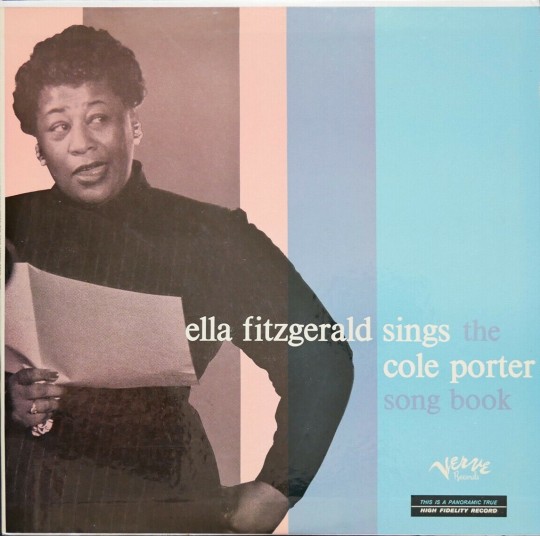
Ella Fitzgerald Sings the Cole Porter Song Book
Ella Fitzgerald
1956, Verve
Cole Porter was the grandson of the richest man in Indiana, a homosexual of unimaginable power, the cleverest socialite since the death of Oscar Wilde. I’m not sure it’d be possible to write songs of such manner-born urbanity without his background, rhymes tumbling down grand staircase rhythms like a platinum slinky of immaculate design, asking the existential questions as only the fabulously wealthy would (“should I order cyanide / or order champagne?”). But Ella Fitzgerald, whose stable working class upbringing dissolved after her mother’s death into a teenaged existence barely above the streets, proved that anyone with sufficient ability (and, importantly, diction) could be these songs’ finest interpreter. The substantial liner notes to my ’76 reissue of Ella Fitzgerald Sings the Cole Porter Song Book don’t mention Porter’s sexuality; they also refer to the fact that a teenaged Fitzgerald looked so poor that numerous impresarios refused to even listen to her tryouts with such genteel vagueness that you get the impression she just had terrible fashion sense. But in truth that sort of mannered elision is the way both artists, each for their own reasons having to do with security and sensibility, would’ve wanted it. On the Porter Song Book, they are simply, archetypally Ella and Cole, elegance and wit personified.
youtube
Even more than 65 years on, it is hard to imagine a greater soundtrack to those special nights when we permit ourselves luxury. It’s in the songs themselves of course, splendid renditions of Porter’s finest (“Begin the Beguine,” “Night and Day,” “You Do Something to Me” and on and on), and in their generous apportioning at eight songs per side over two LPs. Whether you’re listening intently over a glass of wine at home, or if during a party you allow your ear to drift from the conversational hubbub to the glamorous strains that have been subtly guiding the energy of the room all night, there is something marvellous about the Porter Song Book’s inexhaustibility. There is always a song you’ve passed over two dozen times before that suddenly reveals its magic, a couplet that slides itself into your wallet of timeless bon mots (on this listen: “there's someone I'm trying so hard to forget / don't you want to forget someone too?”).
229/365
#ella fitzgerald#cole porter#verve#vocal jazz#american standards#standards#swing#tin pan alley#american songbook#big band#'50s music#female singer#female musicians#anything goes#music review#vinyl record#buddy bregman#queer music
1 note
·
View note
Text
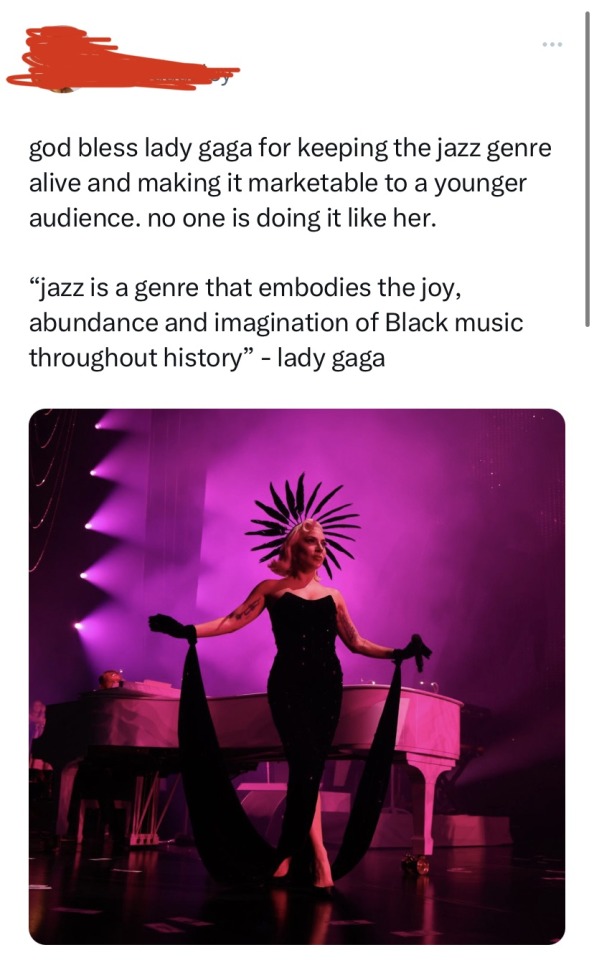
*sighs deeply and checks Lady Gaga’s 2023 Vegas setlist* 1 Broadway, 4 TV/film themes, 2 Latin American standards, 1 Italian-American standard, 1 Neapolitan standard (?????), 1 French standard, and all of 1 jazz standard. Which is mostly just swing and big band.
#music#jazz#lady gaga#*bernie sanders voice* i am once again asking you#not to confuse jazz with swing and/or…literally 20th century pop#really not liking this wholesale lumping into ~jazz standards#trying to gentrify show tunes and movie theme music into the jazz umbrella i see#i got my eyes on you 👁️#i mean i completely get saving the music from obscurity but#let’s not forget the immigrant whites and broadway people involved#like that’s literally the majority of her oldies ser#whatever happened to#the great american songbook#let’s bring that back shall we#cristina is a music lover
0 notes
Text
youtube
Tigran Hamasyan, who is currently touring Europe with music from StandArt, his new album of American standards, has shared this full concert performance of songs from the album. Hamasyan and the trio featured on StandArt—bassist Matt Brewer and drummer Justin Brown—filmed the performance at Pôle PIXEL in Villeurbanne, France.
#tigran hamasyan#standart#american songbook#jazz standards#piano#jazz#matt brewer#justin brown#villeurbanne#pole pixel#nonesuch#nonesuch records#Youtube
0 notes
Video
youtube
but most of all, I wish you love
0 notes
Text
may I present the updated, the bigger, and simply the better...

thank you so much @wrathofrats for helping me gather pictures and organize I and II era ghouls <3
Chain Era I


Ibanez ICB300EX
Gibson Thunderbird (It was played only once and all the pictures are shitty so I don’t know the specifics, only gathered the model by the shape)
Lake Era I


White on black Rickenbacker 4003
Black on white Fender American Performer Precision
Lake Era II


Black on white Fender American Performer Precision
River Era II


Black on white Fender American Performer Precision
Black Fender FSR Player Precision
Delta, Mist & Dewdrop Era III






Black on white Fender American Performer Precision
Black Fender Blacktop Jazz
Rain Era IV




Black on white Fender Standard Jaguar
White Fender Standard Jaguar (they don't really sell them all white so I assume the pickguard is either vinyl wrapped or comes from a different bass)
White Fender American Professional Jazz
Black Fender American Professional II Jazz (they usually come with different colored pickguard so again I assume it's either wrapped or from a different bass)
Rain Era V



Black on white Fender American Professional II Jazz (with additional mods. also, they usually come with different colored pickguard so again I assume its either wrapped or from a different bass)
Black Fender American Professional II Jazz (read parenthesis above)
Black on white Fender Standard Jaguar
if anyone has any questions my askbox is open as usual :3
#the band ghost#nameless ghouls#rain ghoul#dewdrop ghoul#mist ghoulette#delta ghoul#lake ghoul#river ghoul#water ghoul#hypnone gear talks
224 notes
·
View notes
Text
So I'm annoyed at a collage of minidiscs ending up in my timeline because I follow "diskette" but that's not important...
You know how weird the etymology of "diskette" is?
So, it's a portmanteau of "disk" and "cassette".
Disk as in "a round flat thing", and it's the American spelling, because the diskette was invented by IBM, an American company. Disk (usually spelled "disc" in commonwealth countries) comes from the Greek dískos, as in "discus", the circular thing you throw for sport.
And floppy disks are primarily a circle of magnetic material. That's actually how they were first conceived, as a flexible version of the rigid metal magnetic circles used in hard drives. But they quickly realized that it was impossible to keep them clean: fingerprints and dust stick to the surface too easily, ruining them. So they were given a vinyl (and later, plastic) jacket, so they could be safely carried around.
And thus, diskette was coined. Sometimes you'll see it etymologized as "small disk", like a disk-ette, but that's wrong: it's a portmanteau with cassette. Because cassettes were made by taking reel to reel magnetic tape and putting it in a small case, so they can be quickly and reliably loaded.
And why are cassettes called that? Well, it's French. But in French it's quite simple: it's the diminutive of "casse", which means case. It's a little case. You put the tape in a little box. It's a cassette.
So similarly, diskette was made by cassettizing "disk". You put the disk in a little case. It's a disk cassette, a diskette.
This sort of thinking also explains why they're called "floppy disks" when they've been hard plastic since 1984: it's just like how we call cassettes "tapes". They're not tape, they're a little plastic box containing tape. Tape is a thin flexible thing that you wrap around a spool, not a little plastic box. But we call them "tapes"/"a tape" as synecdoche: a part is used to represent the whole. It's a "tape", fittingly because the tape is the important part. It's the part that stores the audio, the rest is just packaging to keep it safe and reliable.
Floppy disks are similarly called such: the floppy part is the magnetic disk inside the vinyl or plastic case. We're calling the whole package by the part that actually stores the data.
And in any case, they were named as such in comparison to "hard disks": the metal or glass surfaces used by hard drives.
Anyway, three final things:
1. You ever wonder why it's Floppy Disk but optical discs? You have a DVD* disc or a CD (compact disc), not a DVD Disk or Compact Disk. I already basically explained it: floppies were invented in the US, and compact discs came from a Philips/Sony partnership: a Dutch/Japanese partnership. So they used the commonwealth spelling, thus it became a standard to refer to optical media as "discs".
2. My favorite silly floppy fact comes from this sort of thing: so the first floppies were 8", then the 5.25" model was invented, and in 1981 we got the 3.5" floppy. These are by far the three most common floppy disks, and those are their names, used nearly** universally in English.
But here's the thing: one of them is wrong.
8 inch floppy disks? They're eight inches even. 5.25 inch floppy disks? They're 5.25 inches even.
3.5" disks are actually 3.543"!
This is for the same reason why we have disk vs disc for floppy and optical media: 8" disks were invented by IBM, an American company. 5.25" disks were invented by Shugart/Wang, both American companies.
3.5" disks were invented by Sony, a Japanese company. They're not 3.5" disks... They're 90mm disks!
But it was already the standard in English that floppy disk formats get called by their size in inches, so it has always been called the 3.5" disk, because that's close enough for jazz.
3. to get back to the first point of this post: minidiscs aren't diskettes. Diskette is for disks, and minidiscs are discs. They're not flexible, they're rigid: minidiscs are actually magneto-optical discs, where there's a small plastic disc like a CD, which is read by a laser but written by a magnetic read head. Since they have to be rigid for the laser to work, they're (rigid) discs, not (flexible) disks. They are confusing, I agree: usually magnetic media is disk, while optical is disc, and disks have cases, while discs are just a plastic circle... But minidiscs are magnetic AND optical, and they're optical but inside a case. They're one of those exceptions that makes taxonomy so difficult. (they're very trans in that way, imo)
* I intentionally didn't expand out the acronym DVD, because the fun fact is about that is that DVD is not an acronym. Not anymore. It was originally supposed to be Digital Video Disc, but the later Digital Versatile Disc to better reflect the non-video uses of the disc, but apparently the official meaning of the acronym is now that it just is the name of the disc. It's a DVD: it doesn't stand for anything.
** one exception to the "universally called by their sizes in English" that I'm aware of is South Africa. For Reasons they just called the 5.25" disks "floppies", and then when 3.5" disks came around, they called them... "stiffies". Yes, this is hilarious. They know.
512 notes
·
View notes
Text

Billie Holiday (born Eleanora Fagan; April 7, 1915 – July 17, 1959) was an American jazz and swing music singer. Nicknamed "Lady Day" by her friend and music partner, Lester Young, Holiday had an innovative influence on jazz music and pop singing. Her vocal style, strongly inspired by jazz instrumentalists, pioneered a new way of manipulating phrasing and tempo. She was known for her vocal delivery and improvisational skills. Holiday won four Grammy Awards, all of them posthumously, for Best Historical Album. She was inducted into the Grammy Hall of Fame and the National Rhythm & Blues Hall of Fame. After a turbulent childhood, Holiday began singing in nightclubs in Harlem, where she was heard by producer John Hammond, who liked her voice. She signed a recording contract with Brunswick in 1935. Collaborations with Teddy Wilson produced the hit "What a Little Moonlight Can Do", which became a jazz standard. Throughout the 1930s and 1940s, Holiday had mainstream success on labels such as Columbia and Decca. By the late 1940s, however, she was beset with legal troubles and drug abuse. After a short prison sentence, she performed at a sold-out concert at Carnegie Hall. She was a successful concert performer throughout the 1950s with two further sold-out shows at Carnegie Hall. Because of personal struggles and an altered voice, her final recordings were met with mixed reaction but were mild commercial successes. Her final album, Lady in Satin, was released in 1958. Holiday died of cirrhosis on July 17, 1959, at age 44. In 2000, she was also inducted into the Rock & Roll Hall of Fame as an early influence; their website states that "Billie Holiday changed jazz forever". She was named one of the 50 Great Voices by NPR; and was ranked fourth on the Rolling Stone list of "200 Greatest Singers of All Time" (2023). Several films about her life have been released, most recently The United States vs. Billie Holiday (2021).
93 notes
·
View notes
Text


By: Gerald Posner
Published: Mar 4, 2024
Newly leaked files from the world’s leading transgender health-care organization reveal it is pushing hormonal and surgical transitions for minors, including stomach-wrenching experimental procedures designed to create sexless bodies that resemble department-store mannequins.
The World Professional Association for Transgender Health documents demonstrate it’s controlled by gender ideologues who push aside concerns about whether children and adolescents can consent to medical treatments that WPATH members privately acknowledge often have devastating and permanent side effects.
Yet the US government, American doctors and prominent organizations nonetheless rely on WPATH guidelines for advice on treating our youth.
The files — jaw-dropping conversations from a WPATH internal messaging board and a video of an Identity Evolution Workshop panel — were provided to journalist Michael Shellenberger, who shared the documents with me.
Shellenberger’s nonprofit Environmental Progress will release a scathing summary report, comparing the WPATH promotion of “the pseudoscientific surgical destruction of healthy genitals in vulnerable people” to the mid-20th-century use of lobotomies, “the pseudoscientific surgical destruction of healthy brains.”
‘Arbitrary’ age limits
The comparison to one of history’s greatest medical scandals is not hyperbole.
It is particularly true, as the files show repeatedly, when it involves WPATH’s radical approach to minors.
When the organization adopted in 2022 its current Standards of Care — relied on by the National Institutes of Health, the World Health Organization and every major American medical and psychiatric association — it scrapped a draft chapter about ethics and removed minimum-age requirements for children starting puberty blockers or undergoing sexual-modification surgeries.
It had previously recommended 16 to start hormones and 17 for surgery.
Not surprisingly, age comes up frequently in the WPATH files, from concerns about whether a developmentally delayed 13-year-old can start on puberty blockers to whether the growth of a 10-year-old girl will be stunted by hormones.
During one conversation, a member asked for advice about a 14-year-old patient, a boy who identified as a girl and had begun transitioning at 4.
The child insisted on a vaginoplasty, a surgery that removes the penis, testicles and scrotum and repositions tissue to create a nonfunctioning pseudo-vagina. It requires a lifetime of dilation. Was he too young at 14?
Marci Bowers, WPATH’s president and a California-based pelvic and gynecologic surgeon who is herself transgender, said she considered any age limit “arbitrary.”
But she would not do it. Why?
“The tissue is too immature, dilation routine too critical.”
In lay terms, that means boys who are too young do not have enough penal tissue for the surgery and the surgeon must harvest intestinal lining to build the faux vagina. Even Bowers admits that can lead to “problematic surgical outcomes.”
She would know since she has performed more than 2,000 vaginoplasties. Her highest-profile patient is 17-year-old Jazz Jennings, the transgender star of reality TV show “I Am Jazz.”
Three corrective surgeries were required to fix problems from the original vaginoplasty.
“She had a very difficult surgical course,” Bowers admitted in a 2022 appearance on the show. “We knew it would be tough — it turned out tougher than any of us imagined.”
Still, Bowers told her colleagues in the internal discussion forum of the best age for an adolescent to undergo surgery: “sometime before the end of high school does make some sense in that they are under the watch of parents in the home they grew up in.”
Christine McGinn, a Pennsylvania plastic surgeon and herself transgender, agreed. McGinn has performed “about 20 vaginoplasties in patients under 18” and thinks the “ideal time in the U.S. is surgery the summer before the last year of high school. I have heard many other surgeons echo this.”
Waiting until teens are older than 18 and in college is problematic, she said: “there are too many stressors in college that limit patients’ ability to dilate.”
Dangers downplayed
WPATH assures patients that surgical and hormonal interventions are tested and safe. It is a different matter in private.
President Bowers, for instance, said publicly in 2022 that puberty blockers are “completely reversible,” although in the internal forum she conceded it is “in its infancy.”
What about children who are infertile for life since they started hormone blockers before they reached puberty?
Bowers told her colleagues the “fertility question has no research.”
At other stages, members talk frankly about the complications for the transition surgery for girls, a phalloplasty in which a nonfunctioning pseudo-penis is fashioned from either forearm or thigh tissue.
It requires a full hysterectomy and surgical removal of the vagina. They also discuss other serious consequences, including pelvic inflammatory disease, vaginal atrophy, abnormal pap tests and incontinence.
A 16-year-old girl who had been on puberty blockers for several years before she was put on testosterone for a year had developed two liver tumors that an oncologist concluded the hormones had caused. Another member described “a young patient on testosterone for 3 years” who had developed “vaginal/pelvic pain/spotting . . . [and] atrophy with the persistent yellow discharge.”
Several colleagues described patients with similar conditions, some with debilitating bowel problems or bleeding and excruciating pain during sex (“feeling like broken glass”).
Vaginal estrogen creams and moisturizers as well as hyaluronic acid suppositories “can be helpful.”
One WPATH member seemed surprised: “The transgender people under my surveillance do not complain about this matter. However, I confess that I have never asked them about it.”
Rise of ‘de-gender’ surgery
The litany of transition surgery’s side effects did not stop WPATH from endorsing far more radical “nullification” surgeries for patients who do not feel either male or female and identify only as nonbinary.
Several dozen so-called “de-gendering” surgeries are designed to create a sexless, smooth cosmetic appearance that is unknown in nature. There is even an experimental “bi-genital” surgery that attempts to construct a second set of genitals.
In 2017, when tabloids reported a 22-year-old man had spent $50,000 to surgically remove his sex organs so he could “transform into a genderless extra-terrestrial,” it seemed a one-off oddity.
But WPATH has enshrined that concept in its Standard of Care — the same document in which the group endorsed for the time first time chemical or surgical castration for patients who identify as eunuchs. (WPATH even linked to the Eunuch Archives, where men anonymously share castration fetishes.)
These science-fiction-like surgeries are not only reserved for adults.
“How do we come up with appropriate standards for non-binary patients?” asked Thomas Satterwhite, a San Francisco-based plastic surgeon who has operated on dozens of patients younger than 18 since 2014. “I’ve found more and more patients recently requesting ‘non-standard’ procedures.”
What are nonstandard procedures? They include “non-binary top surgery,” a mastectomy without nipples. There are brutal procedures for girls that eliminate all or part of the vagina and for boys that amputate the penis, scrotum and testicles.
The goal, as one San Francisco surgical clinic proclaims on its website, “is a smooth, neutral body that is cosmetically free of sexual identification.” On TikTok the trend is called a “flat front.”
‘Too young to understand‘
A particularly intense subject of discussion was whether minors could understand the lifelong consequences of their gender treatments. Minors are presumed by law to be incapable of making an informed decision about having a vasectomy or tubal ligation.
Gender surgeries are an exception, however.
WPATH’s Standard of Care allows all procedures so long as the minor “demonstrates the emotional and cognitive maturity required to provide informed consent/assent for the treatment.”
In a May 2022 internal workshop, “Identity Evolution,” WPATH members conceded that was all but impossible.
Daniel Metzger, the British Columbia endocrinologist who cowrote the Canadian Pediatric Society’s position paper on health care for trans minors, said, “I think the thing you have to remember about kids is that we’re often explaining these sorts of things to people who haven’t even had biology in high school yet.”
Metzger noted adolescents are incapable of appreciating the lifelong consequence of infertility. “It’s always a good theory that you talk about fertility preservation with a 14-year-old,” he said, “but I know I’m talking to a blank wall. They’d be like, ‘ew, kids, babies, gross.’ Or, the usual answer is, ‘I’m just going to adopt.’ And then you ask them, ‘Well, what does that involve? Like, how much does it cost?’ ‘Oh, I thought you just like went to the orphanage, and they gave you a baby.’ . . . I think now that I follow a lot of kids into their mid-twenties, I’m always like, ‘Oh, the dog isn’t doing it for you, right?’”
There is extensive research showing adolescent brains are wired to have little control over rash behavior and are not capable of grasping the magnitude of decisions with lifelong consequences. It is why society doesn’t allow teens to get tattoos or buy guns. Car-rental agencies set 25 as the minimum age for renting a car, and Sweden sets the same limit for deciding on sterilization.
Detransitioners ignored, shunned
Although many WPATH members privately doubt that adolescents can give truly informed consent to life-altering procedures, they must affirm whatever children say about their gender.
Unless, the WPATH files disclose, the patient wants to reverse course and become a so-called detransitioner.
WPATH members mostly dismiss those cases as insignificant or overblown by the media and question whether minors who want to revert to their birth sex really understand what they are doing.
It’s a question that would never be asked for minors who declared themselves to be gender dysphoric.
One case involved a 17-year-old boy, just graduated from high school, who had been on testosterone for two years. He was reported to be “very distraught and angry. He reports he feels he was brainwashed and is upset by the permanent changes to his body.”
A self-described “queer therapist” did not believe any young person could be brainwashed. “In my experience, those stories come from people who have an active agenda against the rights of trans people.”
WPATH President Bowers said that “I do see talk of the phenomenon [detransitioners] as distracting from the many challenges we face.”
‘Frankenstein files’
The leaked files put a spotlight on the danger of mixing ideological activism with medicine and science. They should serve as an urgent wakeup call for the medical associations and government agencies that rely on WPATH guidance for transgender health.
The files might even prompt investigations into how those with distorted personal agendas seized control of the organization at the expense of science and patients.
Investigating what has gone wrong at WPATH might prove uncomfortable for some gender progressives in the Biden administration, none more so than Adm. Rachel Levine, the assistant secretary for health. Levine, the first transgender four-star military officer, is a WPATH member and has lavished praise on the organization.
She says it “assesses the full state of the science and provides substantive, rigorously analyzed, peer-reviewed recommendations to the medical community on how best to care for patients who are transgender or gender non-binary. It is free of any agenda other than to ensure that medical decisions are informed by science.”
Either Levine is unaware of the hormonal and surgical experimentation the group promotes or refuses to acknowledge it.
“The Frankenstein files.”
That is how a pediatrician described the leaked documents after I shared them with her.
Unfortunately, this is no horror novel.
It is a medical travesty playing out in real time, and the casualties are our children.
#Gerald Posner#Michael Shellenberger#WPATH#World Professional Association for Transgender Health#Mia Hughes#WPATH Files#The WPATH Files#medical corruption#medical malpractice#medical scandal#unethical#gender ideology#gender identity ideology#queer theory#first do no harm#religion is a mental illness
27 notes
·
View notes
Audio
HAPPY BIRTHDAY to Doris Day. Many people think of her as the legendary actress of stage and screen, from Hitchcock films to musicals to TV shows. Other people think of her primarily as an extremely good singer due to her many hit songs (650+ recordings between 1947 to 1967)—I do at least 3 of her songs in my care home set. https://www.youtube.com/watch?v=ouj5QAG3PPs ...Then a few people in my orbit know her as the mother of Terry Melcher, her work with animal rights activism, and for running a dog hotel in Carmel. She passed away not long ago at age 97. What a life! Here’s my cover of her first hit record, “Sentimental Journey.” It went to #1 in 1945 and her career took off from there. Meanwhile, HB Doris—thank you for your light.
#dorisday #happybirthday #terrymelcher #johnnyjblair #singeratlarge #sentimenal#journey #greatamericansongbook
2 notes
·
View notes
Text
i just want to say that the average swifty could not handle my career stanning old musical theatre ladies. i will go to a niche one night concert fundraiser event in the hope that i hear a new cover of an american jazz standard from a woman who hasn't released an album in twenty years
14 notes
·
View notes
Text
SEVENTEEN’s MINJI PROFILE
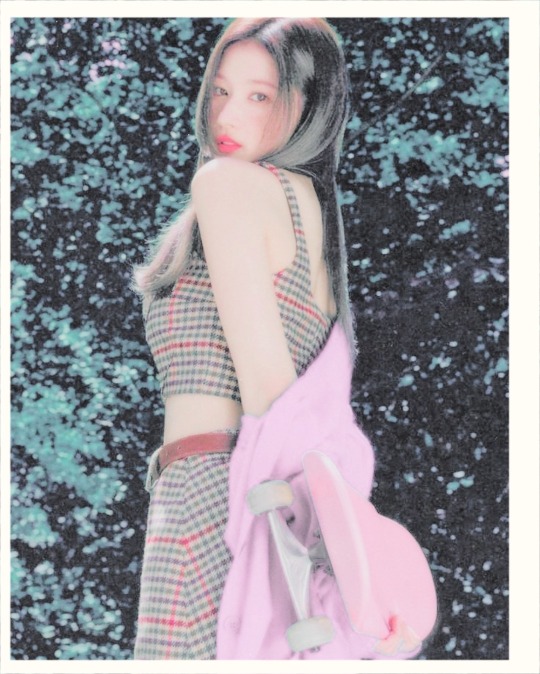

mizuki doi ❪ japanese: 土井 瑞希, hepburn: doi mizuki, born august 15, 1995 ❫, known mononymously as minji ❪ korean: 민지; japanese: ミンジ ❫, is a japanese-american singer based in south korea. she the only female japanese member of the south korean co-ed group seventeen, formed in 2015 by pledis entertainment.
known for her energetic and cheerful personality, she has received recognition in both south korea and abroad, and her popularity has been credited with helping to improve relations between japan and south korea. in gallup korea's annual music poll for 2018, minji was voted the 17th most popular idol in south korea, the highest-ranked japanese individual in the poll. she ranked 15th in the 2019 poll. in 2019, minji also ranked as the most popular female k-pop idol in a survey of soldiers completing mandatory military service in south korea.


。 ゚ ��ঌ ✦໒꒱ ༘*.゚‣ BASIC INFO
୧ ‧₊˚ 🎐 ⋅ NAMES ->
birth name — doi mizuki
english name — mariana doi cortez
hiragana — どい みづき
kanji — 土井 瑞希
୧ ‧₊˚ 🎐 ⋅ NAME MEANING ->
mizuki — from japanese, 瑞 (mizu) meaning "felicitous omen, auspicious" and 希 (ki) meaning "hope”. however, as a girl's name it is most commonly written with the characters for "beauty" and "moon".
mariana — is a feminine name of portuguese origin similar to marianna, meaning "star of the sea." traditionally used by families in portuguese and spanish-speaking countries, mariana has been popular in the u.s. since the 1980s.
୧ ‧₊˚ 🎐 ⋅ NICKNAMES ->
seventeen — mizu, miji, jiji
jeonghan — mizuji
carats — jinny, human prada, shiba inu
parents — mari, mariposa
୧ ‧₊˚ 🎐 ⋅ BIRTHDATE & LOCATION ->
birthdate — august 15, 1995
age — 28
zodiac sign — leo
birthplace — fresno, california, united states
hometown — los angeles, california
residency — fresno, california ❪ 1995 - 1996 ❫, los angeles, california ❪ 1996 - 2013 ❫, seoul, south korea ❪ 2013 - present ❫
nationality — japanese-american
ethnicity — japanese
୧ ‧₊˚ 🎐 ⋅ LANGUAGES ->
korean — 90%
japanese — 95%
english — american, 100%
spanish — latin america, 80%
୧ ‧₊˚ 🎐 ⋅ PHYSICAL DETAILS ->
height — 164 cm ❪ 5'5" ❫
weight — 47 kg ❪ 107 lbs ❫
blood type — a negative
hair color — brown ❪ naturally ❫
eye color — brown
୧ ‧₊˚ 🎐 ⋅ CLAIMS ->
face — sana ❪ twice ❫
vocal — sana ❪ twice ❫ / seulgi ❪ red velvet ❫
rap — yeri ❪ red velvet ❫
dance — bada lee ❪ choreographer ❫ / sana ❪ twice ❫
୧ ‧₊˚ 🎐 ⋅ GENDER & SEXUALITY ->
gender — female
pronouns — she / her
sexual orientation — non-labeled
relationship status — engaged ❪ est. 2023 ❫
。 ゚ ꒰ঌ ✦໒꒱ ༘*.゚‣ CAREER


୧ ‧₊˚ 🎐 ⋅ NAME ->
stage name — minji ❪ pronounced meen-jee ❫
hangul — 민지
origin — since she has japanese descent, she wasn’t completely sure on using her birth-name and asked what could be the best possible names for her. minji was soon chosen as it.
୧ ‧₊˚ 🎐 ⋅ INDUSTRY WISE ->
company — sm entertainment ❪ 2007 - 2013 ❫, pledis entertainment ❪ 2013 - 2020 ❫, hybe labels ❪ 2020 - present ❫
trainee period — 8 years ❪ 2007 - 2015 ❫
dancing period — ballet ❪ 2000 - 2013 ❫, jazz ❪ 2003 - 2013 ❫, pointe ❪ 2009 - 2013 ❫, contemporary ❪ 2007 - 2015 ❫, hip-hop ❪ 2007 - 2015 ❫
୧ ‧₊˚ 🎐 ⋅ ENDORSEMENTS ->
prada — brand ambassador
graff — ambassador
miisha — ambassador
espoir — ambassador
ysl beauty — muse
a'pieu — model
wakemake — model
୧ ‧₊˚ 🎐 ⋅ SEVENTEEN WISE ->
debut age — 19 ❪ seventeen ❫, 22 ❪ solo ❫
group — seventeen
subunit — performance unit
positions — co-leader, main dancer, visual, face of the group, sub vocalist
representative emojis — 🦢 / 🌺
representative color — light blue
individual fandom — ministers
୧ ‧₊˚ 🎐 ⋅ RANKING ->
vocal — 9 / 10
rap — 6 / 10
dance — 10 / 10
visual ❪ korean standard ❫ — 8 / 10
stage presence — 8 / 10
acting — 8 / 10
producing — 4 / 10
songwriting — 7 / 10
choreography — 10 / 10
leadership — 8 / 10
public speaking — 8/ 10
overall ranking — 86 / 100
。 ゚ ꒰ঌ ✦໒꒱ ༘*.゚‣ PERSONAL


୧ ‧₊˚ 🎐 ⋅ MBTI ->
intp-t, the logician
description — a logician ❪ INTP ❫ is someone with the introverted, intuitive, thinking, and prospecting personality traits. these flexible thinkers enjoy taking an unconventional approach to many aspects of life. they often seek out unlikely paths, mixing willingness to experiment with personal creativity.
୧ ‧₊˚ 🎐 ⋅ EDUCATION ->
whitney high school — 2009 - 2013
ucla — 2016 - 2020
୧ ‧₊˚ 🎐 ⋅ PHOBIAS ->
claustrophobia — fear of closed spaces
acrophobia — fear of heights
autophobia — fear of being alone
୧ ‧₊˚ 🎐 ⋅ ALLERGIES ->
pollen — flower pollen
୧ ‧₊˚ 🎐 ⋅ LIKES ->
taking long walks, hard liquor, animal crossing & minecraft, decorating, decluttering, gossip, driving, monster energy, working out, gaming, building lego sets, painting
୧ ‧₊˚ 🎐 ⋅ DISLIKES ->
being late to events, camping, animal abuse, jump scares, creepy dolls, tomatoes, onions, pickles & pickle juice, playing horror games
୧ ‧₊˚ 🎐 ⋅ FAVORITES ->
color — blue, gray & black
food — ice cream, bimbimbap, mochi, kimchi, tacos, burritos, tamales
drink — mango fruit lemonade, sparkling water, blue raspberry flavored drinks, mountain dew, jarritos
movies — the batman, twilight, forest gump, a silent voice, la la land, kill bill, guillermo del toro’s pinocchio, american psycho
tv series — criminal minds, euphoria, south park, breaking bad, one piece, jujustu kaisen, spy x family, death note, the crown, the queen’s gambit, teresa, bridgerton, narcos
emojis — 🫶🤍👍😭☺️🫡
number — 2
season — fall
#svtminji#seventeen oc#seventeen 14th member#💾 ; minji’s profile#kpop#kpop oc#seventeen female addition#seventeen female member#seventeen female oc#kpopidol#kpop original character#kpop gg#fictional kpop oc#fictional idol oc#fictional idol community#fictional kpop idol#fake kpop idol#seventeen added member#seventeen addition#kpop idol
63 notes
·
View notes
Text
Tony Bennett, the American pop and jazz singer who became the torchbearer for the Great American Songbook during a seven decade career, has died aged 96, his publicist said on Friday.
Bennett was perhaps best known for his 1962 signature song I Left My Heart in San Francisco as well as for staging an astonishing career comeback during the 80s and 90s that delivered him sustained popularity into old age. He won 18 Grammy awards, including a lifetime achievement award in 2001, and has sold more than 50m records worldwide.
In 2020, it was announced that he had been diagnosed with Alzheimer’s in 2016. He wrote on Twitter: “Life is a gift – even with Alzheimer’s.” It was revealed that while his cognitive function was impaired, he was still able to sing a whole range of his repertoire.
Bennett’s ability to perform across the genres of pop, big band and jazz won him plaudits and a conveyor belt of willing collaborators. He proved his relevance in 2014 by collaborating with Lady Gaga on the album Cheek to Cheek, which saw the pair tackle a series of jazz standards. It was a No 1 record in the US and made Bennett the oldest living act to reach the top spot, a record he already held thanks to his 2011 album Duets II.
Born Anthony Dominick Benedetto in 1926 to Italian immigrants, Bennett had an impoverished upbringing in Queens, New York. His father died when he was 10 years old, although he was already singing professionally by that point. As a teenager he became a singing waiter, earning money for the family before enrolling to study music and painting at New York’s School of Industrial Art.
Bennett was drafted into the US army in 1944 to fight in France and Germany during the final year of the second world war. It was an experience that scarred him. “It’s legalised murder,” he said during a 2013 Guardian interview.
But he continued to sing while in Germany as part of the occupying force, and in 1949, after returning home, his singing career could begin properly, first under the name Joe Bari and then as Tony Bennett.
His breakthrough came in 1951 with his first No 1, Because of You. The hits continued throughout the decade with songs such as Blue Velvet, Rags to Riches and material that looked towards the swinging sound of his childhood hero Frank Sinatra. Bennett became a teen idol, and when he married his first wife, Patricia Beech, in 1952, 2,000 female fans dressed in black to “mourn” the event outside the New York ceremony.
In 1962 he reached superstar status thanks to his version of the 1953 song I Left My Heart in San Francisco. The song won Bennett two Grammy awards and became a 20th-century pop standard.
Bennett’s style, however, was already looking outdated as the British invasion swept the US charts, and he struggled for relevance during the 1960s. The following decade saw him face a number of personal problems, including the end of his second marriage and serious drug addiction. Yet two albums recorded with pianist Bill Evans would be key to his later re-emergence as a central figure in US music.
The turning point in his life came when Bennett hired his son Danny to be his manager. Ditching the Las Vegas circuit for New York and reuniting with his early 60s pianist and musical director Ralph Sharon proved to be masterstrokes. His 1986 comeback album, The Art of Excellence, was a hit from which he never looked back. Perfectly Frank (1992) – a tribute to his idol Sinatra – topped the US Billboard’s jazz charts, while 1994’s MTV Unplugged saw Bennett win a Grammy for album of the year. Bennett became a fixture on the late-night TV circuit and collaborated with a host of artists such as kd lang, Amy Winehouse, Queen Latifah and Diana Krall, which helped maintain his relevance with younger artists. His 2006 album, Duets: An American Classic, featured appearances from Paul McCartney, Elton John and George Michael.
Bennett was drafted into the US army in 1944 to fight in France and Germany during the final year of the second world war. It was an experience that scarred him. “It’s legalised murder,” he said during a 2013 Guardian interview.
But he continued to sing while in Germany as part of the occupying force, and in 1949, after returning home, his singing career could begin properly, first under the name Joe Bari and then as Tony Bennett.
His breakthrough came in 1951 with his first No 1, Because of You. The hits continued throughout the decade with songs such as Blue Velvet, Rags to Riches and material that looked towards the swinging sound of his childhood hero Frank Sinatra. Bennett became a teen idol, and when he married his first wife, Patricia Beech, in 1952, 2,000 female fans dressed in black to “mourn” the event outside the New York ceremony.
In 1962 he reached superstar status thanks to his version of the 1953 song I Left My Heart in San Francisco. The song won Bennett two Grammy awards and became a 20th-century pop standard.
Bennett’s style, however, was already looking outdated as the British invasion swept the US charts, and he struggled for relevance during the 1960s. The following decade saw him face a number of personal problems, including the end of his second marriage and serious drug addiction. Yet two albums recorded with pianist Bill Evans would be key to his later re-emergence as a central figure in US music.
The turning point in his life came when Bennett hired his son Danny to be his manager. Ditching the Las Vegas circuit for New York and reuniting with his early 60s pianist and musical director Ralph Sharon proved to be masterstrokes. His 1986 comeback album, The Art of Excellence, was a hit from which he never looked back. Perfectly Frank (1992) – a tribute to his idol Sinatra – topped the US Billboard’s jazz charts, while 1994’s MTV Unplugged saw Bennett win a Grammy for album of the year. Bennett became a fixture on the late-night TV circuit and collaborated with a host of artists such as kd lang, Amy Winehouse, Queen Latifah and Diana Krall, which helped maintain his relevance with younger artists. His 2006 album, Duets: An American Classic, featured appearances from Paul McCartney, Elton John and George Michael.
Singing was not Bennett’s only artistic pursuit. His paintings, produced under his birth name, are on display at the Smithsonian Institution and the Butler Institute of American Art. In 2001, he founded the Frank Sinatra School of the Arts in Queens, New York which offers qualifications in fine art, dance, vocal and instrumental music, drama and film.
A lifelong Democrat, Bennett was also a supporter of the civil rights movement who participated in the 1965 Selma to Montgomery marches and refused to perform in apartheid-era South Africa.
Bennett remained determined to perform into his later life. Shortly after his 90th birthday he told the New York Times: “I could have retired 16 years ago, but I just love what I’m doing.”
41 notes
·
View notes
Text
There Are More Beautiful Things Than Beyoncé uses political and pop-cultural references as a framework to explore 21st century black American womanhood and its complexities: performance, depression, isolation, exoticism, racism, femininity, and politics. The poems weave between personal narrative and pop-cultural criticism, examining and confronting modern media, consumption, feminism, and Blackness. This collection explores femininity and race in the contemporary American political climate, folding in references from jazz standards, visual art, personal family history, and Hip Hop. The voice of this book is a multifarious one: writing and rewriting bodies, stories, and histories of the past, as well as uttering and bearing witness to the truth of the present, and actively probing toward a new self, an actualized self. This is a book at the intersections of mythology and sorrow, of vulnerability and posturing, of desire and disgust, of tragedy and excellence.


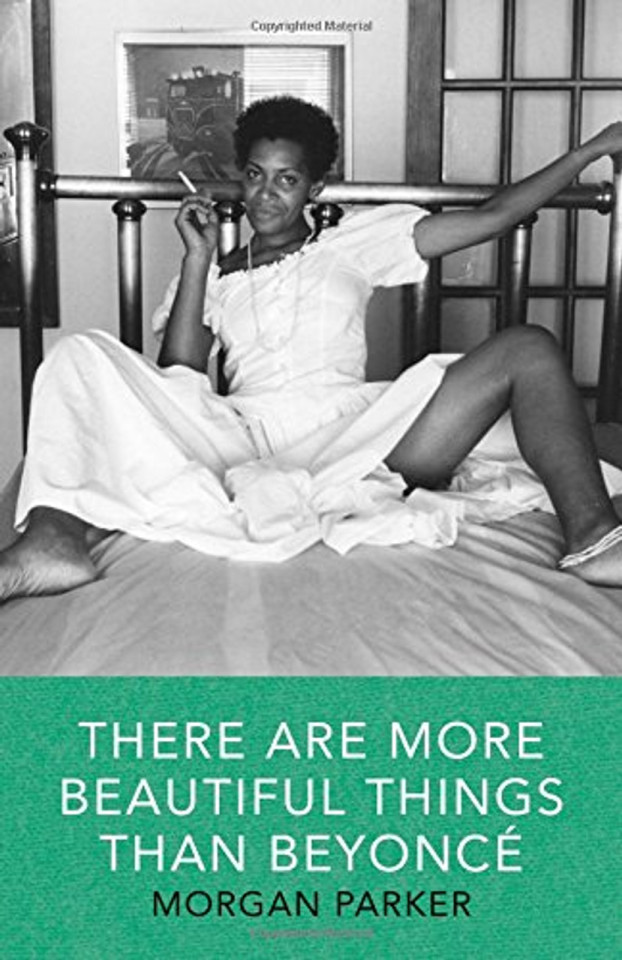
#book: there are more beautiful things than beyonce#author: morgan parker#genre: poetry#genre: feminism#genre: non fiction
7 notes
·
View notes
Text
Roundtable Presentation: Stormy Weather (1943)

Stormy Weather is a 1943 musical directed by Andrew L. Stone. Stormy Weather made history being one of the earliest films with an all-Black cast to be released by a major American studio (being released by Twentieth Century Fox). The film follows the story of Bill Williamson as he recounts it years later in a series of flashbacks which depict his return from serving in World War I. Upon returning to the US, Bill meets Selina, a famous singer and performer. Over the course of the film, Bill grows closer to Selina as he travels to New Orleans in order to pursue the dream of becoming a performer himself. The film is full of numbers which employ jazz and swing music from the early half of the twentieth century.
What are the social aspects within the film’s narrative that align with the film’s songs?
Stormy Weather uses its songs in order to develop the diegesis and tone of the film, in addition to exploring its themes further. The film’s focus on romance and connections between people is explored through its use of songs like “I Can’t Give You Anything But Love, Baby”, “Aint Misbehavin” or the titular “Stormy Weather”. The film pointedly distances itself from making commentary about larger societal and cultural issues, however, as the setting which the characters occupy is devoid of any mention of race or class.
youtube

How do the historiographies of previously recorded songs inform audience relationships with the musical’s narrative and performers?
The historiographies of previously recorded songs help to inform audience relationships with Stormy Weather’s story, characters, and relationships between characters. By intertwining the film’s narrative with familiar songs, Stormy Weather situates itself within the tradition of American jazz and swing. By employing songs which had already built rich histories in American musical tradition, Stormy Weather enriches its narrative centered around performance and art. These known, preexisting songs are used as short hand for narrative development and fit seamlessly into the conceit of the film.

What musical genre/style drives the film’s score, and how does the genre/style (re)define the film as a musical?
Stormy Weather primarily employs jazz standards in developing its sonic tapestry. Its choice of songs covers a century’s worth of music – from the mid-1800s to the 1940s. Many of the songs used by the film were written or originally performed by Black artists like Ethel Waters or Andy Rafaz. By highlighting jazz music in a film depicting an all-Black cast, Stormy Weather helps to reclaim jazz within the Black community after a generation of appropriation by white audiences.
However, as most of the creative body behind Stormy Weather was white, the film depicts Black characters and narratives through a white lens. The film employs minstrel songs in its catalogue like “De Camptown Races”. The song was written in inaccurate AAVE and was intended to be sung in minstrel shows by white performers wearing blackface. “De Camptown Races” was introduced by the Christey’s Minstrel in 1850 and would be performed in minstrel shows throughout the nineteenth century.
youtube
While Stormy Weather was historic for its representation of the Black community, it also perpetuated harmful stereotypes through its ties to minstrelsy. The film opened up opportunities for Black actors, singers, and dancers in Hollywood by highlighting Black talent in leading roles; however, it fell short of making any statement on the treatment of people of color within companies or studios and it offered little characterization for its cast, a result of its own ties to racism and racist attitudes.
10 notes
·
View notes